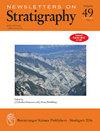Foraminifers in the Holkerian Stratotype, regional substage in Britain: key taxa for the Viséan subdivision
IF 2.1
3区 地球科学
Q1 GEOLOGY
引用次数: 6
Abstract
Foraminiferal revision of the Holkerian Stratotype of Britain at Barker Scar, Holker Hall, south Cumbria, UK, allows the subdivision of the section into the Cf4δ, Cf5α and Cf5β subzones (the latter being further subdivided into lower Cf5β1 and upper Cf5β2 intervals). The base of Cf5α subzone at the base of bed C and base of Cf5β subzone from the middle part of bed C, occur at 14 m and 10.5 m, respectively, below the traditional basal boundary of the Holkerian at bed K. The lower boundaries of these foraminiferal subzones occur within the main interval affected by dolomitization in the section, which poses problems in defining precisely the bases for these subzones. Nevertheless, in spite of the dolomitization, a more or less continuous foraminiferal record allows a solid correlation of the base of the Cf5β with the preserved succession in the Livian Substage (defined in Belgium, but also used in France), and it is assumed that the base of this substage should correspond to the base of the Cf5α subzone. The base of the Cf5α subzone can be correlated with the base of the Russian Tulian Substage, since it contains many taxa in common with the Holkerian. However, further investigation is needed to establish other levels of correlation (e. g., base of the Cf5β subzone) higher up in the Holkerian substage. All of these problems suggest that the Holkerian, as it is currently recognised, and the Barker Scar stratotype section, in particular, should be reconsidered, and a new para-stratotype section, ideally devoid of dolomitization, should be located and investigated, in order to corroborate the occurrence of the Cf5α and Cf5β foraminiferal subzones compared to those recognised in the Barker Scar Stratotype. These modifications would allow identification of an apparent synchronous faunal event forming the basis of a future subdivision of the Visean.英国Holkerian层型的有孔虫,区域亚阶段:vissaman细分的关键分类群
英国坎布里亚郡南部Holker Hall Barker Scar英国Holkerian层型的有孔虫修正,将剖面细分为Cf4δ、Cf5α和Cf5β亚带(后者进一步细分为Cf5β1下段和Cf5β2上段)。C层底部的Cf5α亚带底部和C层中部的Cf5β亚带底部分别位于k层Holkerian传统基底边界下方14 m和10.5 m处。这些有孔虫亚带的下边界位于剖面中受白云化作用影响的主要层段内,这给这些亚带的基底的精确定义带来了问题。然而,尽管存在白云化作用,但一个或多或少连续的有孔虫记录允许将Cf5β的基底与Livian亚阶段(比利时定义,但也在法国使用)保存的演替进行可靠的对比,并且假设该亚阶段的基底应对应于Cf5α亚带的基底。Cf5α亚带的基底与俄罗斯图连亚期基底有一定的相关性,因为它包含许多与Holkerian相似的类群。然而,需要进一步的研究来建立Holkerian亚期更高的其他水平的相关性(例如Cf5β亚区的碱基)。所有这些问题都表明,应重新考虑霍尔克系,特别是巴克疤痕层型剖面,并定位和研究一个理想的不含白云化的准层型剖面,以证实与巴克疤痕层型相比,Cf5α和Cf5β有孔虫亚带的存在。这些修改将允许识别一个明显的同步动物事件,形成未来维西安细分的基础。
本文章由计算机程序翻译,如有差异,请以英文原文为准。
求助全文
约1分钟内获得全文
求助全文
来源期刊

Newsletters on Stratigraphy
地学-地质学
CiteScore
5.50
自引率
4.50%
发文量
22
审稿时长
>12 weeks
期刊介绍:
Newsletters on Stratigraphy is an international, peer-reviewed journal with a focus on stratigraphic issues that are relevant for a broad geoscientific community. Papers published in Newsletters on Stratigraphy use (and ideally integrate) stratigraphic methodologies from a wide field of disciplines, including (but not limited to) biostratigraphy, chronostratigraphy, chemostratigraphy, and magnetostratigraphy.
The results have implications for paleogeographic reconstructions, paleoceanography, paleoclimate, biotic evolution, basin development, or regional and supraregional correlation.
Papers published in Newsletters on Stratigraphy comprise original research articles, background information on ongoing work of e.g., the International Stratigraphic Commission (ICS) and the International Subcommission on Stratigraphic Classification (ISSC), and review articles. There are no page charges for the publication of regular papers.
 求助内容:
求助内容: 应助结果提醒方式:
应助结果提醒方式:


